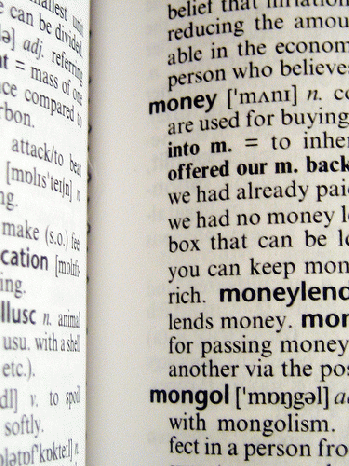Now we turn our attention to alternatives to our present money that are currently being considered.
There are a number of initiatives out there that are in the continuum between private for profit money and the simple money described here. Central Government issued money (usually thought of a nationalizing the Federal Reserve) is a major one in terms of discussion. While it is an improvement on the private for profit money system we now live with, it has its problems, when understood in terms of what we have learned in studying simple money.
First, it is created by fiat, ex nihlo, out of nothing, by a central authority like our present casino money. Just like in our present system, in creating money by fiat, there is no recognition that the claim on commitment being assumed by the government has a corresponding commitment; and who is making that commitment (like our present money, the taxpayer constituents of the government).
Like private for profit money, Government created money is a loan on the part of the citizens to the Government. Unlike bank created money and simple money, the loan created by Government money doesn't have a repayment date. This makes it even easier to ignore the fact that it is in reality a loan.
While Government money served well in the Colonial, Revolutionary War, and Civil War periods of our history, the size of central government now and therefore the probability of manipulation in a faceless bureaucracy is much greater.
While the money may be used for social needs, there is no guarantee that this will happen. The decision process is centralized. If a distributed decision making structure is provided to gain citizen input, it is not part of the basic monetary structure, and can be manipulated or done away with. This is an example of a top down structure trying to act as if it is bottom up. It can work, but is subject to being controlled by the central authority.
Because Government money is created by fiat, ex nihlo, with no repayment date, the amount of money in circulation is not self regulated, and has to be guesstimated and centrally managed, so there isn't too much or too little in circulation to prevent inflation or deflation. This also leaves the system open to manipulation.
Proposals for quantitative easing/'helicopter money' are an example of abuse in money creation. As noted before, in the simple system, this is not an issue, as the money supply is automatically managed by its users, as they make their transactions.
Because the money created by quantitative easing has been absorbed by the financial community rather than becoming a part of the money pool for the real economy, it has done nothing to improve the real economy. It has simply increased the claims on commitment of the financial community toward the real economy and kept the money system from breaking down because of its need for constant money supply growth.
A second weakness of Government created money proposals is that they leave the private for profit banks in place as the interface between the government and the users of money. In so doing nothing is done to deal with the use of profit to accumulate money capital, and use it only for issues that produce more profit for those who have accumulated it, rather than having all capital created by its users only when needed, and only for things that are in their best interest.
History has shown, both in the case of the Revolutionary War Continentals, and the Civil War Greenbacks, that government created money leads to the private for profit banking industry, over time, manipulating the system and re-taking control of money creation.
A third difficulty is getting legislation supporting Government money passed by the present government. Members of the present government are so bought and paid for by the banking industry, that expecting them to allow a change that would decrease that power is a non-starter. Just as the insurance industry, which doesn't have nearly the clout of the money industry, kept universal health insurance off of the table, we have to expect government money to also be off the table.
Cooperative banks and City or State owned banks, following the example of the Bank of North Dakota are other initiatives. While they do move limited control to a more local level, they are still a part of the system operated by the central bankers, the House of the Casino metaphor.
In contrast to both central government and private money, in the simple system, local people have a democratic stake in outcomes because of basic system structure. They make the decisions of when and for what their money is to be created. They can directly feel the responsibility for the decisions they make on how their money is to be spent, making money creation decisions in their best interest.
In addition, in a system composed of nested smaller systems, failures, if they occur, are more local and much less catastrophic than in a megasystem such as the money we now have or central government issued money.





